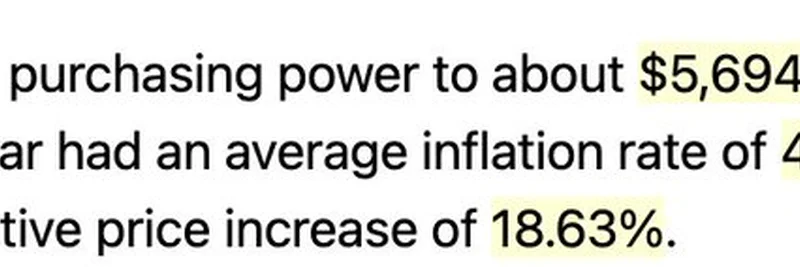In the fast-paced world of cryptocurrency, hitting all-time highs (ATHs) is a big deal. But what if the numbers don't tell the whole story? A recent tweet from Giulio Rebuffo, a lead developer at ErigonEth, sheds light on this by adjusting Ethereum's (ETH) ATH for inflation. It's a reminder of how traditional money, or fiat, loses value over time, pushing more people toward crypto alternatives like meme tokens.
Rebuffo points out that while ETH is approaching its nominal ATH—the peak price without adjustments—the real ATH, when you factor in inflation, sits around $5.7k. This calculation stems from the U.S. dollar's purchasing power decline since 2021, when ETH last hit its record of about $4,800.
Breaking Down the Inflation Math
Let's keep it simple: Inflation is the rate at which prices for goods and services rise, eroding the value of money. According to the tweet's data, $4,800 in 2021 buys the same as roughly $5,694 today—an increase of about 18.63% cumulatively, or 4.36% per year on average.
This means if ETH reaches $4,800 again nominally, it's not truly surpassing its old peak in terms of real value. To beat the inflation-adjusted ATH, it'd need to climb to around $5,700. Tools like the U.S. Bureau of Labor Statistics CPI calculator can help verify these figures, showing how fiat currencies like the USD steadily depreciate.
Why This Matters for Crypto Enthusiasts
Crypto was born partly as a hedge against inflation—think Bitcoin's narrative as "digital gold." Ethereum, as the backbone of decentralized finance (DeFi) and non-fungible tokens (NFTs), follows suit. Rebuffo's tweet underscores why holding fiat can be risky: it silently eats away at your wealth.
For blockchain practitioners, this is a call to action. ETH's ultrasound money properties, thanks to mechanisms like EIP-1559 which burns fees, aim to make it deflationary over time. This contrasts sharply with fiat's inflationary nature, making ETH and similar assets appealing for long-term value storage.
Tying It to Meme Tokens
At Meme Insider, we're all about meme tokens—those fun, community-driven coins like Dogecoin or newer entrants on Solana and Base chains. But inflation affects them too. Meme tokens often thrive on hype and virality, but their valuations are quoted in fiat terms. If the dollar weakens, a meme coin's "ATH" might not reflect true gains.
Consider this: If a meme token like PEPE hits a new high in USD but inflation has risen 5% since the last peak, you're not really ahead. Savvy traders adjust for this by comparing against stable benchmarks or other cryptos. Plus, many meme projects incorporate deflationary mechanics, such as token burns, to combat value erosion—mirroring ETH's approach.
This perspective encourages diversifying into assets that outpace inflation. Meme tokens, with their potential for explosive growth, can serve as high-risk, high-reward plays in a portfolio designed to beat fiat devaluation.
Looking Ahead in the Blockchain Space
As ETH nears its nominal ATH, keep an eye on real metrics. Tools and resources abound for tracking inflation-adjusted prices—check out platforms like CoinMarketCap or TradingView for charts that factor in CPI data.
Rebuffo's insight isn't just about ETH; it's a broader commentary on why crypto matters. In a world where central banks print money freely, decentralized alternatives offer a way to preserve and grow wealth. Whether you're into blue-chip cryptos like ETH or the wild world of meme tokens, understanding inflation's role is key to smarter investing.
Stay tuned to Meme Insider for more breakdowns on how economic trends intersect with blockchain innovations. If you're building or trading in the space, remember: True value goes beyond the numbers on the screen.


